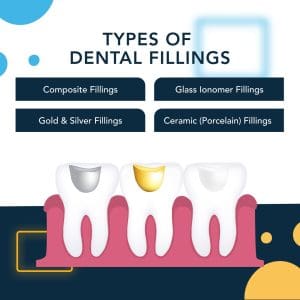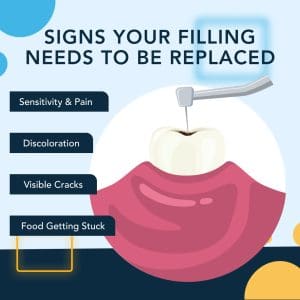Dental fillings are a common solution for treating cavities and tooth damage, but many people wonder how long they actually last. While fillings are designed to be durable and long-lasting, they aren’t permanent and may need replacement over time due to wear, decay, or damage. The lifespan of a filling depends on the material used, oral hygiene habits, and daily wear and tear. In this article, we’ll explore how long fillings last, signs they need replacement, and ways to extend their lifespan.
What Are Dental Fillings?
Dental fillings are materials used to repair cavities, cracks, or minor tooth damage, restoring the tooth’s strength and function. When decay creates a hole in the enamel, a dentist removes the damaged area and fills it with a durable material like composite resin, amalgam, gold, or ceramic. Fillings play a vital role in dental restoration and cavity treatment, helping to prevent further decay, protect the tooth’s structure, and support long-term dental health. With proper oral hygiene and care, fillings can last for years before needing replacement.
Types of Dental Fillings
Not all tooth fillings are the same, as different materials offer unique benefits in terms of durability, appearance, and cost. The right choice depends on factors like cavity size, tooth location, and personal preference. Some fillings blend naturally with teeth, while others are known for their strength and longevity. Understanding the different types of fillings can help you make the best decision for your oral health.
Composite Fillings (Tooth-Colored Fillings)
Composite fillings are made from a tooth-colored resin that blends seamlessly with natural teeth, making them a popular choice for visible areas like front teeth. They bond directly to the tooth enamel, providing strong support while requiring minimal drilling. Though less durable than metal options, composite fillings offer a natural appearance and are a great choice for smaller cavities.
Amalgam Fillings (Silver Fillings)
Amalgam fillings are made from a combination of silver, mercury, tin, and copper, making them extremely durable and long-lasting. They are often used for back teeth, where chewing pressure is greatest. While cost-effective and strong, their silver color makes them more noticeable, and they require more removal of tooth structure compared to composite fillings.
Gold Fillings
Gold fillings are highly durable and long-lasting, often lasting 20 years or more with proper care. Made from a gold alloy, they resist wear and corrosion, making them ideal for back teeth that endure heavy chewing. Though more expensive than other options, gold fillings are valued for their strength, reliability, and longevity. However, they are more noticeable than tooth-colored alternatives.
Ceramic (Porcelain) Fillings
Ceramic fillings, often made of porcelain, provide a natural-looking, stain-resistant alternative to composite and metal fillings. They are custom-made to match tooth color and are highly resistant to staining. While more brittle than other materials and typically more expensive, ceramic fillings are a great choice for aesthetic restoration in visible areas of the mouth.
Glass Ionomer Fillings
Glass ionomer fillings release fluoride, helping to protect teeth from further decay. They are often used for children’s cavities or in areas where minimal chewing pressure is applied. Though not as strong or long-lasting as other fillings, they provide a protective benefit for patients at higher risk of tooth decay, particularly in baby teeth or non-load-bearing areas.
Common Reasons for Getting a Filling
Dental fillings are one of the most common tooth restoration treatments, helping to repair damage and maintain oral health. Whether caused by tooth decay, cracks, or wear, fillings restore the tooth’s structure and function, preventing further issues. Understanding why fillings are needed can help you recognize early signs of dental problems and take action before more extensive treatment is required.
Treating Cavities Caused by Tooth Decay
Tooth decay is the most common reason for getting a dental filling. When bacteria break down enamel, they create cavities that, if left untreated, can lead to pain, infection, and tooth loss. Fillings restore the damaged area, preventing decay from spreading and protecting the tooth’s structure while allowing you to chew and function normally.
Repairing Cracked or Fractured Teeth
A cracked or fractured tooth can result from biting hard foods, grinding teeth, or experiencing an injury. Without treatment, cracks may worsen, leading to sensitivity, pain, or infection. A dental filling helps seal the crack, preventing further damage and restoring the tooth’s strength, ensuring it remains functional and protected from further breakage.
Fixing Old or Worn Fillings
Over time, dental fillings can wear down, loosen, or even crack due to chewing pressure, temperature changes, or grinding. When a filling deteriorates, bacteria can enter the gaps, leading to new decay. Replacing worn or damaged fillings helps maintain tooth integrity, preventing more extensive procedures like crowns or root canals.
Restoring Teeth After Minor Trauma
Injuries from falls, sports accidents, or biting hard objects can cause minor chips or fractures in a tooth. A dental filling can restore the tooth’s shape, strength, and function, preventing further deterioration. This simple and effective treatment helps preserve your natural tooth while maintaining a healthy, complete smile.
Factors That Affect the Lifespan of Fillings
The lifespan of a tooth filling depends on several factors, including the material used, daily habits, and overall dental health. While fillings are designed to be durable, they aren’t permanent and may wear down over time. Understanding what impacts their longevity can help you take the right steps to extend their lifespan and avoid the need for early replacement.
Type of Filling Material
Different filling materials offer varying levels of durability and longevity. Amalgam fillings are one of the longest-lasting options, often remaining intact for 10-15 years, while composite fillings provide a more natural look but typically last 5-10 years. Gold and ceramic fillings are even more durable but come at a higher cost. Selecting the right material plays a key role in determining how long a filling will stay effective.
Oral Hygiene Routine
Good oral hygiene habits help extend the lifespan of dental fillings. Brushing twice a day with fluoride toothpaste, flossing daily, and visiting the dentist for regular cleanings prevent decay from forming around or under the filling. Poor oral hygiene can lead to new cavities, weakening the tooth and shortening the life of the filling.
Diet and Eating Habits
Certain foods and habits can wear down fillings faster. Chewing hard foods, like ice or hard candy, increases the risk of cracking or chipping a filling. Sugary and acidic foods can contribute to decay around the filling, leading to early replacement. Avoiding excessive grinding, clenching, and sticky foods helps protect fillings and ensures they last as long as possible.
Teeth Grinding and Clenching
Bruxism, or habitual teeth grinding and clenching, puts excessive pressure on fillings, causing them to wear down, crack, or break over time. This is especially problematic for composite and ceramic fillings, which are more prone to damage. Wearing a night guard and addressing grinding habits can help protect fillings and extend their lifespan.
Cavity Size and Location
Larger fillings and those placed on chewing surfaces, like molars, experience more stress from daily use. Fillings in front teeth often last longer because they endure less pressure than those used for biting and grinding food. The size and placement of a filling impact its longevity, with smaller fillings generally lasting longer than larger restorations.
Regular Dental Checkups
Routine dental visits are essential for monitoring the condition of fillings and detecting early signs of wear or damage. Dentists can catch issues before they lead to more significant problems, like decay under a filling or cracks that require a replacement filling. Regular cleanings and exams help ensure your fillings stay intact and function properly for as long as possible.
Signs Your Filling Needs to Be Replaced
Over time, dental fillings can wear down, loosen, or become damaged, putting your oral health at risk. When a filling starts to fail, it can lead to tooth sensitivity, discomfort, or even decay beneath the filling. Recognizing the early warning signs can help you get timely treatment and prevent more serious dental issues.
 Sensitivity or Pain Around the Filling
Sensitivity or Pain Around the Filling
If you experience tooth sensitivity when eating hot, cold, or sweet foods, it could indicate that your filling is worn or damaged. Pain when biting down may also signal a loose or cracked filling. Sensitivity can worsen if decay develops underneath the filling, so it’s important to have it checked by a dentist as soon as possible.
Visible Cracks or Wear in the Filling
Over time, fillings can develop cracks or signs of wear due to chewing pressure, teeth grinding, or natural aging. Small fractures may not cause immediate discomfort but can allow bacteria to enter, leading to new decay. If you notice visible damage or uneven surfaces on your filling, it may need to be repaired or replaced to prevent further issues.
Discoloration or Rough Edges
Fillings, especially composite fillings, can become discolored over time, blending less naturally with surrounding teeth. Additionally, rough edges or changes in texture may indicate erosion or breakdown of the filling. If a filling no longer feels smooth or starts looking noticeably different from the rest of the tooth, it could be time for a replacement.
Food Getting Stuck Around the Filling
A filling should create a sealed surface to prevent food and bacteria from getting trapped. If you notice food consistently getting stuck around a filling, it may be loose, worn down, or have small gaps forming around its edges. This can increase the risk of decay and should be addressed by a dentist to prevent further damage.
Schedule Your Next Dental Checkup Today
Keeping up with regular dental checkups is essential for maintaining the health of your fillings and overall oral hygiene. Over time, fillings can wear down, crack, or loosen, leading to pain, sensitivity, or decay. A Davie dentist can assess the condition of your fillings, catch early signs of damage, and recommend timely repairs to prevent more serious issues. If left untreated, a failing filling could lead to the need for crowns or root canals, so routine checkups are key.
If you’re searching for a dentist near me, visiting a dentist in Davie, Florida, ensures you receive expert care for your dental fillings. Whether you need a new filling, a replacement, or a routine checkup, a skilled dentist in Broward County can help maintain your oral health and keep your smile strong. Schedule your next dental checkup today to ensure your fillings stay intact and functional for years to come!
May 16, 2025

 Adult
Adult




 Sensitivity or Pain Around the Filling
Sensitivity or Pain Around the Filling